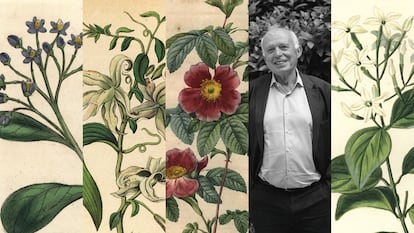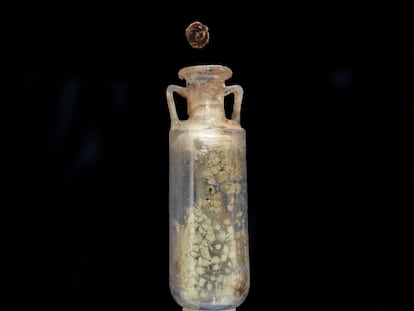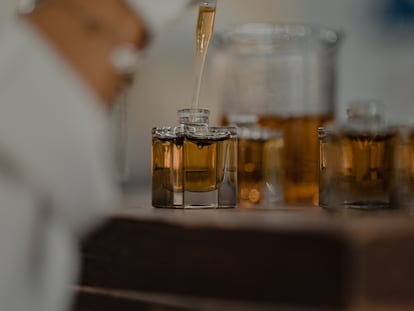Dominique Roques seeks out ingredients for perfumes: ‘Every farmer must be happy. If you don’t pay a fair price, it doesn’t work’
The present and future of fragrances cannot be understood without paying attention to the first steps in the process of perfumery. ‘The consumer has pushed for the system to improve,’ says ingredients explorer Dominique Roques


Dominique Roques has been traveling the world for more than three decades in search of raw materials with which to enrich the world of perfumery. “I’m often asked if I find new flowers, new bark, and so on when I travel, but it doesn’t work like that. It is very difficult to introduce something really new to the perfumer’s palette. You can go deep into the rainforest and discover a flower, but then what do you do with it? Can you reproduce it?” he says, highlighting some of the work that is hidden behind the magic of fragrances. “For example, aromas are captured in the desert and perfumers try to replicate them in the laboratory, using natural and synthetic ingredients. Many of the efforts to come up with new notes are made by playing with raw materials that already exist, but are produced in different ways. For example, from a rose you can have an absolute extracted with a solvent, or you can have an essence and then fractionate it. One of the greatest technical steps has been the use of CO2 for an extraction in which the solvents disappear and leave no residue. It’s expensive, but it’s more successful. And there is a lot of interesting research in this field, such as playing with microwave extraction.”
Roques, the author of In Search of Perfumes (HarperCollins), is semi-retired, after retiring from Firmenich, a multinational perfume and flavor manufacturer. Today he collaborates with them on individual projects. He traveled to Madrid to attend the Perfume Academy’s annual awards ceremony, which used his book as inspiration for the staging of this year’s event. He has traveled around the world several times tracking down flowers, seeds, and resins, but above all potential partners with whom to establish a regular trade in these raw materials.
While the mystique of the sector has intentionally focused on the beauty of the bottles, this “sourcer” advocates shedding light on the entire process. “There are those who believe that luxury begins in the perfume bottle, but I believe that we have to go back further, to the raw materials.” Today, something that does not take into account the entire chain cannot be understood as luxury. It starts with vanilla from Madagascar, cinnamon from Sri Lanka, benzoin from Laos, patchouli from Indonesia, or vetiver from Haiti. “When I started going to these countries in the late 1980s, there was secrecy on the part of the perfume companies — for economic reasons, of course. Sometimes there were ridiculous prices and sometimes the industry took advantage of the poverty in many countries. This has changed, but only in the last 15 years at most. The consumer has more information and has put more and more pressure on the sector, which has been profoundly transformed. It can’t be called greenwashing. Before, there was a buyer who did what he wanted and no one noticed, and now there is brutal transparency. Not everything is perfect, because there are complex problems to be solved, but it has improved.”
Total traceability is complicated, because many producers buy their crops from hundreds of different farmers, “but you already know which town it comes from, you know the quantities, you know the prices. There are large groups that want to demand that everything be certified, from start to finish, but they forget that the situation in Somaliland or Haiti is not the same as it is in France or Spain. There is a clash between Western values and the reality of life in these countries. There are things you can clarify, change, or improve, but you can’t impose your standard on their tradition. It’s a matter of talking with and understanding the producers, who are generally very young people who want to do a good job.”
The market is turning towards associations with these producers in which they can spread the risk: “Their main problem is that the industry is not able to guarantee its purchases for three years.” These depend on the success of the launches that happen at a dizzying pace, and if these do not work as expected, the weakest link in the chain ends up paying the highest price: “A buyer can approach a cardamom producer in Guatemala saying that he is going to have a big launch with a brand, and that he is going to need so many tons, and if it doesn’t work later, how is that producer going to tell his farmers that he can’t buy their harvest from them? That is why I believe that evolution passes through a partnership relationship.”
It is feasible: in the world’s main cities, the demand for fragrances continues to grow. According to McKinsey, its global sales were close to $70 billion in 2022 and are expected to continue growing until reaching $100 billion in 2027. “The sector is very profitable, with margins of up to 90% in the luxury subsegment. With an increase in premium, prestige fragrances have an estimated annual growth rate of between 8 and 13% over the next five years.”
Margins and ingredients will be affected by factors such as the climate crisis: “At the moment it is noticeable through the lack of water in many countries. In France, the world’s leading producer of lavendin (Lavandula latifolia), farmers on the Valensole plateau in Provence once had enough rain to irrigate their crops. But for the last five years it has been changing, and they are realizing that to survive they will have to water the lavandin, which was something unthinkable in the past. They will have to adapt and invest, because every problem has a solution, but at sometimes a very significant cost. And so we come to the super interesting topic of the price of natural products compared to synthetic products, which are much cheaper.”
What is the risk? Perfumers could potentially resort to alternatives created in the laboratory and drop fundamental productive frameworks for many regions. It has already happened with Indian mint, which now has fierce competition from synthetic menthol. “The industry must choose, but in the knowledge that some natural products may possibly disappear. If perfumery continues tomorrow without balsam of Peru, who will notice? You can make fantastic perfumes without balsam of Peru, but the bottom line is that there may come a time when the palette of natural products is greatly reduced. And it is a crime against the wealth of perfumers when it comes to composing.”
“For me it is a fairly simple issue: every farmer growing rose, patchouli, or tuberose should be happy. If a price is not paid for the country lord to be happy, something is not working.” The future is hopeful, especially illuminated by a new wave of buyers who are seeking quality and who appreciate the ethics of the entire process. They understand that a bottle contains much more than an intoxicating aroma. “I think that niche perfumery will do a lot of good by placing high-quality products on the market that will allow the consumer to understand their value and be willing to pay for it,” Roques acknowledges. Perhaps it is the only way to preserve the craftsmanship behind this atavistic alchemy. “One of my most incredible memories is from Somaliland, when I discovered the smell of incense coming from the trees. It is something unique. Humans discovered this magical tree from which incense could be extracted 5,000 years ago, surely the first perfume in history.”
Sign up for our weekly newsletter to get more English-language news coverage from EL PAÍS USA Edition
Tu suscripción se está usando en otro dispositivo
¿Quieres añadir otro usuario a tu suscripción?
Si continúas leyendo en este dispositivo, no se podrá leer en el otro.
FlechaTu suscripción se está usando en otro dispositivo y solo puedes acceder a EL PAÍS desde un dispositivo a la vez.
Si quieres compartir tu cuenta, cambia tu suscripción a la modalidad Premium, así podrás añadir otro usuario. Cada uno accederá con su propia cuenta de email, lo que os permitirá personalizar vuestra experiencia en EL PAÍS.
¿Tienes una suscripción de empresa? Accede aquí para contratar más cuentas.
En el caso de no saber quién está usando tu cuenta, te recomendamos cambiar tu contraseña aquí.
Si decides continuar compartiendo tu cuenta, este mensaje se mostrará en tu dispositivo y en el de la otra persona que está usando tu cuenta de forma indefinida, afectando a tu experiencia de lectura. Puedes consultar aquí los términos y condiciones de la suscripción digital.
More information
Últimas noticias
ChatGPT fails the test: This is how it endangers the lives of minors
The late consecration of women artists in their 90s
The Florida Keys tourist paradise is besieged by immigration agents: ‘We’ve never seen anything like this’
The latest scam on WhatsApp behind the legal dream: using immigration status as bait
Most viewed
- Families demand repatriation of bodies of Colombians who died in Ukraine: ‘This war is a slaughterhouse for foreigners’
- The low-cost creative revolution: How technology is making art accessible to everyone
- Liset Menéndez de la Prida, neuroscientist: ‘It’s not normal to constantly seek pleasure; it’s important to be bored, to be calm’
- Christian Louboutin: ‘Young people don’t want to be like their parents. And if their parents wear sneakers, they’re going to look for something else’
- ‘El Limones’ and the growing union disguise of Mexican organized crime










































